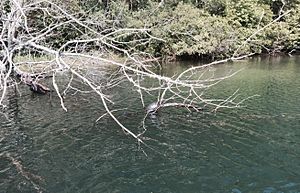Plymouth red-bellied turtle facts for kids
Quick facts for kids Pseudemys rubriventris bangsi |
|
|---|---|
 |
|
| Plymouth red-bellied turtle on Long Pond in Plymouth, Massachusetts | |
| Conservation status | |
| Scientific classification |
|
| Kingdom: | Animalia |
| Phylum: | Chordata |
| Class: | Reptilia |
| Order: | Testudines |
| Suborder: | Cryptodira |
| Family: | Emydidae |
| Genus: | Pseudemys |
| Species: | |
| Subspecies: |
P. r. bangsi
|
| Trinomial name | |
| Pseudemys rubriventris bangsi Babcock, 1937
|
|
The Plymouth red-bellied turtle (Pseudemys rubriventris bangsi) is a special type of freshwater turtle. It's also known as the Plymouth red-bellied cooter. This turtle was the very first freshwater turtle in the United States to be listed as an endangered animal. This means it's at risk of disappearing forever. The United States Fish and Wildlife Service put it on this important list.
Scientists now think that the Plymouth red-bellied turtle might not be a separate subspecies. They believe it's actually a part of the northern red-bellied cooter (Pseudemys rubriventris). Even so, this turtle helps extend the area where the northern red-bellied cooter lives by a lot, about 30 to 40 percent.
Contents
About the Plymouth Red-Bellied Turtle
This turtle gets its name from its reddish plastron, which is the bottom part of its shell. Its upper shell, called the carapace, can be brown or black. The turtle also has flattened or slightly curved scutes (the bony plates on its shell) on its back. Each scute around the edge of its shell has a red bar.
A cool arrow-shaped stripe runs on top of its head, right between its eyes, all the way to its nose. Adult Plymouth red-bellied turtles are about 10 to 12.5 inches (25 to 32 cm) long. Male turtles have longer, straight claws on their front feet.
Where They Live and Their Home
This special turtle lives in the Plymouth Pinelands area of Massachusetts. It likes to spend most of its time in deep, clear freshwater bodies. These places usually have muddy bottoms and lots of plants. You can find them in lakes, ponds, creeks, rivers, streams, and even marshes.
How Many Turtles Are There?
For a long time, these turtles were only found in Plymouth County, Massachusetts. Then, the state started working to create new groups of turtles in other areas. In the 1980s, there were only about 200 to 300 turtles left. By 2007, the number of breeding age turtles grew to about 400 to 600, living in 20 different ponds. In 2011, they were found in 17 ponds.
Turtle Behavior and Habits
The Plymouth red-bellied turtle often likes to sunbathe on rocks. This helps it keep its body temperature just right. If it gets scared while sunning, it quickly slips back into the water. During the cold winter months, this turtle will hibernate. It buries itself in the mud at the bottom of rivers and stays there until spring.
Who Hunts Them?
Young turtles and their eggs are often hunted by animals like skunks, raccoons, birds, and fish.
Life Cycle and Reproduction
In the spring and summer, female turtles build nests in the sand to lay their eggs. Meanwhile, the male turtles are busy looking for food. A female turtle can lay between 5 and 17 eggs at one time.
The eggs take about 73 to 80 days to hatch. They usually hatch when the temperature is around 25°C (77°F). When they first hatch, the baby turtles are very small, about 32 millimeters (1.3 inches) long. In the wild, these turtles can live for a long time, usually between 40 and 55 years.
Protecting the Plymouth Red-Bellied Turtle
The Plymouth red-bellied turtle is an endangered species for a few reasons. One reason is that skunks, a natural predator, sometimes eat too many of their eggs and young. Pollution from chemicals like herbicides, which are dumped into streams and ponds, also harms them.
Another big problem is the loss of their habitat. People sometimes fill in ponds to build houses, which takes away the places where these turtles live. To help protect them, the Massasoit National Wildlife Refuge was created in 1983. This special area helps conserve the Plymouth red-bellied turtle and its home.
- Graham, T.E. Summary report to Mass. Department of Fish and Wildlife, December 31, 1984.


